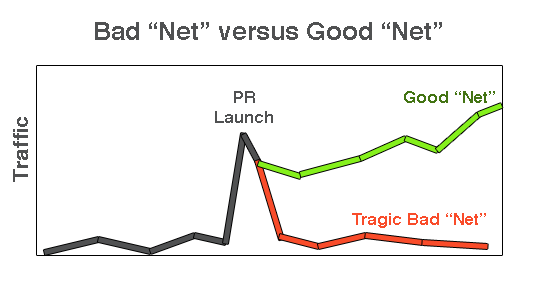Vinicius Vacanti is co-founder and CEO of Yipit. Next posts on how to acquire users for free and how to raise a Series A. Don’t miss them by subscribing via email or via twitter.
Note: This post is loosely based on our experience 2 years ago when TechCrunch covered Yipit’s launch.
You wake up earlier than normal, grab your iPhone which you slept on top of and do a twitter search for your startup name.
Boom. A tweet every 5 minutes.
People are re-tweeting the TechCrunch article covering your startup’s launch. TechCrunch just said you might be the next big thing. You even see a few random people recommending your startup to their followers.
You giddily open your email and you’ve got a bunch of messages from your friends at the co-working space congratulating you on the TechCrunch piece. One of your friends says “you’re famous!” Your parents respond with “Congratulations!” after they read the email where you explained to them that TechCrunch was a really big deal.
You crawl over to your laptop and pull up Google Analytics. You’ve never seen anything like this. Your previous traffic looks like a flat line next to yesterday’s huge 8,253 visits.
After months of toiling away in obscurity, you feel like you’ve finally made it. People know what you’re working on now. People all over the world are now using your product. Paul Graham should have never rejected you from YC.
You then you pull up your event log in SQLPro to see what all these new users are doing.
Hmm. That’s weird. Even though you had 8,000+ visits, you only signed up a little over 1,000 users. “Sounds like we need to do some work on that landing page”, you think.
You start looking at the emails of the users who signed-up and get annoyed with some of the fake emails: asdf@gmail.com, fu@gmail.com. “Ugh. Going to be hard to retain those users since they won’t be getting notification emails,” you mutter to yourself.
1,000 new users is still really good except a bunch of them didn’t really go through the full sign-up process. A bunch of people didn’t put in their interests. How are they supposed to have a good experience without customizing their interests? You run a quick SQL query and the number of users that made it through the sign-up flow: 200.
You send off a quick text to your co-founder asking if he was really sure that sign-up flow bug had been fixed.
And, while you don’t want to do it, you force yourself to see how many people came back today. The answer: 3. Really? Just 3. It’s still early, but can you really expect more than 50 to come back today?
You are happy to see people are still signing-up via the TechCrunch article but way less than yesterday. You do some quick math and then it hits you. When it’s all said and done, TechCrunch, best case scenario, will have given you a grand total of 200 active users.
Was that our big launch?
Why didn’t more people sign-up? Why didn’t people complete the sign-up flow? Why weren’t people coming back?
Now that people covered our startup, how are we supposed to get more press?
Why aren’t our users pushing their actions to Facebook and Twitter?
We got some users to invite their friends but why aren’t their friends accepting the invite?
How are we supposed to get a viral coefficient greater than 1.0 when people won’t share on Facebook or accept their friends’ invite?
Should we try SEO?
Chris Dixon said 10 million users is the new 1 million users. 10 million?! We have 400 active users.
Now what?
Welcome to startups.
Vinicius Vacanti is co-founder and CEO of Yipit. Next posts on how to acquire users for free and how to raise a Series A. Don’t miss them by subscribing via email or via twitter.










